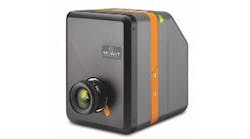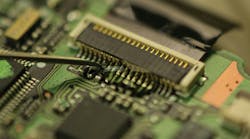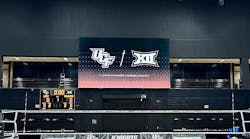WAYNE, PA -- Independence LED announced today that it submitted this proposal to www.ClimateCoLab.org for the "Building" contest on how to increase building energy efficiency to reduce greenhouse gas emissions.
Stop Waiting: Lighting uses 20% or more of a building's electricity, and LEDs save 50% on energy and last longer than traditional lights.
These four Action points work in concert to maximize the potential for positive change.
ACTION A: 5 Spoke Wheel Process
The goal is to develop sustainable triple bottom line approach focusing on People, Planet, and Profit.
The spokes of the proposed process wheel include five key action steps that repeat over multiple years for continuous process improvement: #1. Research; #2. Innovate; #3. Inspire; #4. Deploy; #5. Showcase…and then Repeat. The process hopefully seems logical, but too often only a few of the steps are executed to their full potential. Adoption of a rigorous process may significantly increase the pace of positive impact. The steps come from multiple years of managing www.GREENandSAVE.com and www.IndependenceLED.com and may serve as a meaningful way to take lessons learned within private sector resource development and clean technology manufacturing to guide a new generation of best practices.
Five Spoke Process Highlights:
#1. Research -- A solid foundation requires rigorous analysis of the highest and best use of available technology, time, and resources. Top research findings drive recommendations for short and long term tactical actions that yield top Return on Investment (ROI) on Energy Savings, Renewable Energy Creation, and CO2 Emission Reduction. Analysis may also include Total Cost of Ownership, Grey Energy Consumption, and Lifecycle Waste Impact from cradle to grave. Research opens avenues to celebrate what works and leapfrog to #3. "Inspire" or to dig in to fill a void with phase #2. "Innovate."
#2. Innovate -- When research reveals an opportunity to improve or invent new processes or technology then realistic cost-benefit analysis is key to determine viability. Market adoption and pace of impact on clean technology programs have often failed to meet initial investor expectations. Creating energy is often more difficult and expensive that saving energy, and "Reduce" reinforces this fact as the first of the three words in the mantra, "Reduce, Reuse, Recycle."
#3. Inspire -- Research findings or new Innovations in any cycle and category only make a positive impact if someone is inspired to act. Students, adults, home owners, business owners, and public servants are often driven to act by different motivators. Disruptive technology and behavioral paradigm shifts often take repeated and multiple types of inspiration across time and media.
#4. Deploy -- Those that are inspired to act may not have the means to do so. For energy-efficiency and renewable energy measures, the cost of new technology is often a hurdle to adoption. New rebates, financing and creative power purchase and savings share programs help lubricate the engine of change now more than ever. Measurement is the key to management, so energy audits are often a key component of inspiration to localize the relevancy of impact along with the global benefits. The mantra "Think Global, Act Local," rings true at this phase. Reward structures such as utility incentives and tax deductions as the "carrots" vs penalties "sticks" may also serve to increase deployment at a macro scale.
#5. Showcase -- Celebrate the small, medium, and large victories across a diverse range of traditional and new media avenues. Go Viral and leverage the cost-effectiveness of marketing via digital video profiles, testimonials, case studies, and social media. Encourage those that have demonstrated environmental leadership to share how they "walk the talk." Leading by example and disclose the kWh reduction or production, waste reduction, and any other measurable performance to inspire others.
Repeat -- Repeat the process by circling back to the research phase after ongoing measurement and verification of the previous results. Refine the tactics before to moving into the next recommendation cycle and update the best practices based on new available technology and learnings from the field. This continuous improvement loop relies on critical thinking about what could work better and also an agility to adjust in a timely manner as the cycle continues.
ACTION B: Global Green Network
Refine and promote a Global Green Network to support the multi-spoke Green Wheel process
This proposal is not about a single solution, but it is all about a systemic approach focused on improved process and "strength in numbers" to fill in gaps within any one organization, idea, or initiative. Often environmental initiatives, with the best intentions, fall short of accomplishing impact goals, because the skill sets of the team do not cover the range of the process. Experts in GHG emissions research may not have high skills in viral marketing necessary to communicate the findings. As the environmental movement has grown in strength at a global level, the opportunity to cross-pollinate and leverage the networking capacity of the internet is more real now than ever.
This proposal encourages the development of Global Green Network, where the millions of individuals and hundreds of thousands of companies and organizations can offer to share "opt in" email outreach and volunteer or offer discounted products or services to support causes that are meaningful for them. Imagine a web resource like a "Match.com" for environmental professionals, volunteers, and students that are like minded. Volunteers and student interns are one of the greatest untapped resources that, when directed through process driven multi-step programs, can help activate meaningful change. This approach helps build an army of "Climate Change Agents" that are most likely ready and willing to join the Global Energy Revolution given the right recruiting and process oversight. The ultimate benefit of a "strength in numbers" approach is manifested when those that are engaged at a young age can influence family and friends though live conversation and viral marketing for decades. No one technology or initiative alone will change the game, because change comes though people connecting with people and sharing their concerns and aspirations over time.
ACTION C: Motivation Tactics
This proposal includes refining and promoting the following sample inspiration tactics to motivate positive action:
#1. The Return on Investment (ROI) motivator: The money you can save each year on energy may be 25% or greater for a decade or longer, which is far better than most other investments.
#2. The Net Operating Income (NOI) motivator: You building or business will be more profitable, because the energy savings goes to the bottom line with a penny saved as a penny earned. The Capitalization Rate on the sale of property provides a multiplier well over the cost of the investment.
#3: The Act Now for incentives motivator: Take advantage of Rebates and other incentives before they expire.
#4: The Sunk Cost motivator: If you are planning on installing technology, like lights or air conditioning, for an addition, renovation, tenant fit-out, or new construction then upgrade from regular technology to clean technology. The clean tech is a fraction of the cost of replacing technology for existing infrastructure, because the offset of "old" technology was in the budget.
#5: $0 Upfront Cost motivator: Take advantage of the diverse range of financing, equipment leasing, and savings share programs to generate savings without investing funds.
#6: The Reduced Maintenance Cost motivator: Take advantage of the longer lasting clean technology on building systems from insulation and on-demand water heaters to HVAC and lighting. The maintenance labor saved by not having to replace the equipment as frequently is in addition to the energy savings.
#7: The Productivity motivator: Take advantage of a healthier happier and in many cases statistically more productive workforce with clean technology. This is a new "Biometric" aspect that is manifested in studies for toxic free solid state Light Emitting Diode technology.
#8: The GREEN brand motivator: Retain and attract new customers given certain loyalties to sustainable practices. This is also manifested in LEED Certifications and Energy Star points for buildings and many tenants look for the eco-factor in choosing new leases.
#9: The CO2 Reduction motivator: Save money and the planet with GHG reduction. On average 1.34 lbs of CO2 in the U.S. are saved for every kWh saved. Clean technology helps reduce the demand for electricity consumption, which is often generated, all or in part, by burning coal.
#10: The Stewardship motivator: "The Earth is not a gift from our parents, it is a loan from our children." And "We do not inherit the earth from our ancestors; we borrow it from our children." These quotes are attributed to many sources including a Kenyan proverb. The stewardship motivator could be enough for many people, but the multi-point approach above is about touching as many different mindsets as possible to reach the goal of a symbiotic relationship between humankind and planet earth.
ACTION D: Lighting Best Practices Guide
Many home owners, business owners, and public servants, have become overwhelmed with the range of "energy smart" lighting solutions and smart control options, such as lighting occupancy sensors, light harvesting, and demand response with utility companies. So, the clutter of information slows the pace of adoption. Clear best practices guides that match the needs of the different facility types will help decision makers take appropriate action.
This proposal includes the build out of an anchor Best Practices Lighting Guide and then the development of tailored sub-set solutions to address different markets such as:
Commercial Offices
Education (K-12 Schools and Colleges and Universities)
Health Care Facilities
Industrial: Factory, Warehouse, and Distribution Centers
Retail
(More)
For a sample of the type of content in the Best Practices Guide relative to technical tips for business and building owners see this Lighting Specifications White Paper: http://www.independenceled.com/LED-Specification-White-Paper
Who will take these actions?
Buildings are literally all around us in the private and public sector and at the residential, commercial, industrial, institutional, and military levels. So, this is an "all hands on deck" approach to energy savings and a "SWITCH THE LIGHTS" communications initiative.
Sample communications to date: (videos)
Grade School Students:
https://www.youtube.com/watch?v=BnfLRUnxTcg&feature=youtu.be
https://www.youtube.com/watch?v=7Qw544DQ_AY
Young Professionals:
https://www.youtube.com/watch?v=ZeWVyTqyOwk
U.S. Lighting Professionals:
https://www.youtube.com/watch?v=ULzGAXvqaAg
Minority Owned Business Professionals:
https://www.youtube.com/watch?v=t5x7nopgLgs
European Lighting Professionals:
(e.g. German) https://www.youtube.com/watch?v=eVD_imd9Cwo
Military Veterans:
https://www.youtube.com/watch?v=v1EqoygmAeY
Business Owners/Managers "Showcase":
https://www.youtube.com/watch?v=5IVCfCQawUE
http://www.independenceled.com/monro
Reaching across party lines in the US and around the world:
Conservation of energy and natural resource should not be a liberal or conservative cause in any one country but a Global Cause. Many conservatives have questioned the economic viability of sustainability practices and incentives without realizing that what is good for the planet is also good for business. Successful change at a meaningful level will require winning over conservatives since so many business decision makers default to conservative politics. One of the heroes of American conservatives, President Ronald Reagan, is by no means the individual that sustainability advocates would put on a "Green" pedestal. However, Reagan provided a statement in his January 1984 State of the Union Address that could serve as a building block within a larger structural case for environmental intelligence, "Preservation of our environment is not a liberal or conservative challenge, it's common sense."
Where will these actions be taken?
This program is designed for global deployment given that the WHEEL Process can scale across the internet and the supporting network. Plus, LED manufacturers have sales representatives and distributors around the world.
Win / Win: To date, the "Clean-Tech" market has largely focused on renewable power and often found disappointing Return on Investment (ROI) results, vs. the high ROI (typically over 25%) that can come for any business through energy efficiency measures like lighting retrofits. Reducing energy consumption is easier than creating new renewable power, and the old adage rings true, "A penny saved is a penny earned." With 1.34 lbs of CO2 emission reduction for every kilowatt hour saved (http://www.independenceled.com/led_tube_co2_reduction). Simple measures can save money and the environment. What is good for business can also be good for the planet.
Immediate Solution: Businesses of any size and type as well as government facilities from the local fire house to the State Department, can switch to energy efficient lights right now. According to the U.S. Department of Energy, there are 2.3 billion fluorescent tubes in American ceilings (http://www.independenceled.com/t12_to_led_tube_white_paper).
The ubiquitous 4' tube uses 32 watts while leading Light Emitting Diode (LED) tubes run on only 12 watts. The 20w savings x 3,000 hours / year adds up to 60 annual kilowatt hours saved. At the U.S. average of about $.12 / kWh, the annual savings is $7.20 per tube. At 1.34 lbs of CO2 saved per kWh, 80.4 lbs of CO2 are saved per tube per year. With 2.3 billion tubes, the annual savings is $16.5 billion and 184.9 billion lbs of CO2. Over the 20 year life of the LEDs, the savings is $331.2 billion and 3.7 trillion lbs of CO2. That is just for changing the fluorescent tube lights in the U.S. With socket and other bulbs, the savings numbers could double.
How much will emissions be reduced or sequestered vs. business as usual levels?
In the U.S., over the 20 year life of the LEDs, the savings would yield 3.7 trillion lbs of CO2 emission reduction for commercial sector and a matching number for homes. Over 7 trillion lbs is over 3.5 billion tons. Since the U.S uses over 20% of the world's power, the global impact over two decades could be over 15 billion tons of CO2 emission reduction. It's time to start changing out more lights.
See the calculations and source data in the previous section on where the actions will take place.
What are other key benefits?
Beyond energy savings and CO2 emission reduction, there are multiple other benefits to LED technology in buildings:
Improved concentration levels for office workers, students, given the reduced "flicker" effect over fluorescent lighting
Less migraine headaches than with fluorescent lighting for people sensitive to the fluorescent flicker.
Toxic Free -- No Mercury in LEDs
Energy savings thought transportation cost reduction since the LEDs last longer and do not need to have trucks rolling around for service and replacement calls.
Recyclability. See the Cradle to Cradle Example here: http://www.independenceled.com/cradle_to_cradle_production
Stop Waiting: Lighting uses 20% or more of a building's electricity, and LEDs save 50% on energy and last longer than traditional lights.
These four Action points work in concert to maximize the potential for positive change.
ACTION A: 5 Spoke Wheel Process
The goal is to develop sustainable triple bottom line approach focusing on People, Planet, and Profit.
The spokes of the proposed process wheel include five key action steps that repeat over multiple years for continuous process improvement: #1. Research; #2. Innovate; #3. Inspire; #4. Deploy; #5. Showcase…and then Repeat. The process hopefully seems logical, but too often only a few of the steps are executed to their full potential. Adoption of a rigorous process may significantly increase the pace of positive impact. The steps come from multiple years of managing www.GREENandSAVE.com and www.IndependenceLED.com and may serve as a meaningful way to take lessons learned within private sector resource development and clean technology manufacturing to guide a new generation of best practices.
Five Spoke Process Highlights:
#1. Research -- A solid foundation requires rigorous analysis of the highest and best use of available technology, time, and resources. Top research findings drive recommendations for short and long term tactical actions that yield top Return on Investment (ROI) on Energy Savings, Renewable Energy Creation, and CO2 Emission Reduction. Analysis may also include Total Cost of Ownership, Grey Energy Consumption, and Lifecycle Waste Impact from cradle to grave. Research opens avenues to celebrate what works and leapfrog to #3. "Inspire" or to dig in to fill a void with phase #2. "Innovate."
#2. Innovate -- When research reveals an opportunity to improve or invent new processes or technology then realistic cost-benefit analysis is key to determine viability. Market adoption and pace of impact on clean technology programs have often failed to meet initial investor expectations. Creating energy is often more difficult and expensive that saving energy, and "Reduce" reinforces this fact as the first of the three words in the mantra, "Reduce, Reuse, Recycle."
#3. Inspire -- Research findings or new Innovations in any cycle and category only make a positive impact if someone is inspired to act. Students, adults, home owners, business owners, and public servants are often driven to act by different motivators. Disruptive technology and behavioral paradigm shifts often take repeated and multiple types of inspiration across time and media.
#4. Deploy -- Those that are inspired to act may not have the means to do so. For energy-efficiency and renewable energy measures, the cost of new technology is often a hurdle to adoption. New rebates, financing and creative power purchase and savings share programs help lubricate the engine of change now more than ever. Measurement is the key to management, so energy audits are often a key component of inspiration to localize the relevancy of impact along with the global benefits. The mantra "Think Global, Act Local," rings true at this phase. Reward structures such as utility incentives and tax deductions as the "carrots" vs penalties "sticks" may also serve to increase deployment at a macro scale.
#5. Showcase -- Celebrate the small, medium, and large victories across a diverse range of traditional and new media avenues. Go Viral and leverage the cost-effectiveness of marketing via digital video profiles, testimonials, case studies, and social media. Encourage those that have demonstrated environmental leadership to share how they "walk the talk." Leading by example and disclose the kWh reduction or production, waste reduction, and any other measurable performance to inspire others.
Repeat -- Repeat the process by circling back to the research phase after ongoing measurement and verification of the previous results. Refine the tactics before to moving into the next recommendation cycle and update the best practices based on new available technology and learnings from the field. This continuous improvement loop relies on critical thinking about what could work better and also an agility to adjust in a timely manner as the cycle continues.
ACTION B: Global Green Network
Refine and promote a Global Green Network to support the multi-spoke Green Wheel process
This proposal is not about a single solution, but it is all about a systemic approach focused on improved process and "strength in numbers" to fill in gaps within any one organization, idea, or initiative. Often environmental initiatives, with the best intentions, fall short of accomplishing impact goals, because the skill sets of the team do not cover the range of the process. Experts in GHG emissions research may not have high skills in viral marketing necessary to communicate the findings. As the environmental movement has grown in strength at a global level, the opportunity to cross-pollinate and leverage the networking capacity of the internet is more real now than ever.
This proposal encourages the development of Global Green Network, where the millions of individuals and hundreds of thousands of companies and organizations can offer to share "opt in" email outreach and volunteer or offer discounted products or services to support causes that are meaningful for them. Imagine a web resource like a "Match.com" for environmental professionals, volunteers, and students that are like minded. Volunteers and student interns are one of the greatest untapped resources that, when directed through process driven multi-step programs, can help activate meaningful change. This approach helps build an army of "Climate Change Agents" that are most likely ready and willing to join the Global Energy Revolution given the right recruiting and process oversight. The ultimate benefit of a "strength in numbers" approach is manifested when those that are engaged at a young age can influence family and friends though live conversation and viral marketing for decades. No one technology or initiative alone will change the game, because change comes though people connecting with people and sharing their concerns and aspirations over time.
ACTION C: Motivation Tactics
This proposal includes refining and promoting the following sample inspiration tactics to motivate positive action:
#1. The Return on Investment (ROI) motivator: The money you can save each year on energy may be 25% or greater for a decade or longer, which is far better than most other investments.
#2. The Net Operating Income (NOI) motivator: You building or business will be more profitable, because the energy savings goes to the bottom line with a penny saved as a penny earned. The Capitalization Rate on the sale of property provides a multiplier well over the cost of the investment.
#3: The Act Now for incentives motivator: Take advantage of Rebates and other incentives before they expire.
#4: The Sunk Cost motivator: If you are planning on installing technology, like lights or air conditioning, for an addition, renovation, tenant fit-out, or new construction then upgrade from regular technology to clean technology. The clean tech is a fraction of the cost of replacing technology for existing infrastructure, because the offset of "old" technology was in the budget.
#5: $0 Upfront Cost motivator: Take advantage of the diverse range of financing, equipment leasing, and savings share programs to generate savings without investing funds.
#6: The Reduced Maintenance Cost motivator: Take advantage of the longer lasting clean technology on building systems from insulation and on-demand water heaters to HVAC and lighting. The maintenance labor saved by not having to replace the equipment as frequently is in addition to the energy savings.
#7: The Productivity motivator: Take advantage of a healthier happier and in many cases statistically more productive workforce with clean technology. This is a new "Biometric" aspect that is manifested in studies for toxic free solid state Light Emitting Diode technology.
#8: The GREEN brand motivator: Retain and attract new customers given certain loyalties to sustainable practices. This is also manifested in LEED Certifications and Energy Star points for buildings and many tenants look for the eco-factor in choosing new leases.
#9: The CO2 Reduction motivator: Save money and the planet with GHG reduction. On average 1.34 lbs of CO2 in the U.S. are saved for every kWh saved. Clean technology helps reduce the demand for electricity consumption, which is often generated, all or in part, by burning coal.
#10: The Stewardship motivator: "The Earth is not a gift from our parents, it is a loan from our children." And "We do not inherit the earth from our ancestors; we borrow it from our children." These quotes are attributed to many sources including a Kenyan proverb. The stewardship motivator could be enough for many people, but the multi-point approach above is about touching as many different mindsets as possible to reach the goal of a symbiotic relationship between humankind and planet earth.
ACTION D: Lighting Best Practices Guide
Many home owners, business owners, and public servants, have become overwhelmed with the range of "energy smart" lighting solutions and smart control options, such as lighting occupancy sensors, light harvesting, and demand response with utility companies. So, the clutter of information slows the pace of adoption. Clear best practices guides that match the needs of the different facility types will help decision makers take appropriate action.
This proposal includes the build out of an anchor Best Practices Lighting Guide and then the development of tailored sub-set solutions to address different markets such as:
Commercial Offices
Education (K-12 Schools and Colleges and Universities)
Health Care Facilities
Industrial: Factory, Warehouse, and Distribution Centers
Retail
(More)
For a sample of the type of content in the Best Practices Guide relative to technical tips for business and building owners see this Lighting Specifications White Paper: http://www.independenceled.com/LED-Specification-White-Paper
Who will take these actions?
Buildings are literally all around us in the private and public sector and at the residential, commercial, industrial, institutional, and military levels. So, this is an "all hands on deck" approach to energy savings and a "SWITCH THE LIGHTS" communications initiative.
Sample communications to date: (videos)
Grade School Students:
https://www.youtube.com/watch?v=BnfLRUnxTcg&feature=youtu.be
https://www.youtube.com/watch?v=7Qw544DQ_AY
Young Professionals:
https://www.youtube.com/watch?v=ZeWVyTqyOwk
U.S. Lighting Professionals:
https://www.youtube.com/watch?v=ULzGAXvqaAg
Minority Owned Business Professionals:
https://www.youtube.com/watch?v=t5x7nopgLgs
European Lighting Professionals:
(e.g. German) https://www.youtube.com/watch?v=eVD_imd9Cwo
Military Veterans:
https://www.youtube.com/watch?v=v1EqoygmAeY
Business Owners/Managers "Showcase":
https://www.youtube.com/watch?v=5IVCfCQawUE
http://www.independenceled.com/monro
Reaching across party lines in the US and around the world:
Conservation of energy and natural resource should not be a liberal or conservative cause in any one country but a Global Cause. Many conservatives have questioned the economic viability of sustainability practices and incentives without realizing that what is good for the planet is also good for business. Successful change at a meaningful level will require winning over conservatives since so many business decision makers default to conservative politics. One of the heroes of American conservatives, President Ronald Reagan, is by no means the individual that sustainability advocates would put on a "Green" pedestal. However, Reagan provided a statement in his January 1984 State of the Union Address that could serve as a building block within a larger structural case for environmental intelligence, "Preservation of our environment is not a liberal or conservative challenge, it's common sense."
Where will these actions be taken?
This program is designed for global deployment given that the WHEEL Process can scale across the internet and the supporting network. Plus, LED manufacturers have sales representatives and distributors around the world.
Win / Win: To date, the "Clean-Tech" market has largely focused on renewable power and often found disappointing Return on Investment (ROI) results, vs. the high ROI (typically over 25%) that can come for any business through energy efficiency measures like lighting retrofits. Reducing energy consumption is easier than creating new renewable power, and the old adage rings true, "A penny saved is a penny earned." With 1.34 lbs of CO2 emission reduction for every kilowatt hour saved (http://www.independenceled.com/led_tube_co2_reduction). Simple measures can save money and the environment. What is good for business can also be good for the planet.
Immediate Solution: Businesses of any size and type as well as government facilities from the local fire house to the State Department, can switch to energy efficient lights right now. According to the U.S. Department of Energy, there are 2.3 billion fluorescent tubes in American ceilings (http://www.independenceled.com/t12_to_led_tube_white_paper).
The ubiquitous 4' tube uses 32 watts while leading Light Emitting Diode (LED) tubes run on only 12 watts. The 20w savings x 3,000 hours / year adds up to 60 annual kilowatt hours saved. At the U.S. average of about $.12 / kWh, the annual savings is $7.20 per tube. At 1.34 lbs of CO2 saved per kWh, 80.4 lbs of CO2 are saved per tube per year. With 2.3 billion tubes, the annual savings is $16.5 billion and 184.9 billion lbs of CO2. Over the 20 year life of the LEDs, the savings is $331.2 billion and 3.7 trillion lbs of CO2. That is just for changing the fluorescent tube lights in the U.S. With socket and other bulbs, the savings numbers could double.
How much will emissions be reduced or sequestered vs. business as usual levels?
In the U.S., over the 20 year life of the LEDs, the savings would yield 3.7 trillion lbs of CO2 emission reduction for commercial sector and a matching number for homes. Over 7 trillion lbs is over 3.5 billion tons. Since the U.S uses over 20% of the world's power, the global impact over two decades could be over 15 billion tons of CO2 emission reduction. It's time to start changing out more lights.
See the calculations and source data in the previous section on where the actions will take place.
What are other key benefits?
Beyond energy savings and CO2 emission reduction, there are multiple other benefits to LED technology in buildings:
Improved concentration levels for office workers, students, given the reduced "flicker" effect over fluorescent lighting
Less migraine headaches than with fluorescent lighting for people sensitive to the fluorescent flicker.
Toxic Free -- No Mercury in LEDs
Energy savings thought transportation cost reduction since the LEDs last longer and do not need to have trucks rolling around for service and replacement calls.
Recyclability. See the Cradle to Cradle Example here: http://www.independenceled.com/cradle_to_cradle_production
Contact:
Charlie Szoradi - Independence LEDE-mail:
[email protected]Submit new products, case studies/projects, and other press releases at http://www.ledsmagazine.com/content/leds/en/addcontent.html and http://www.ledsmagazine.com/content/leds/en/iif/add.html.




